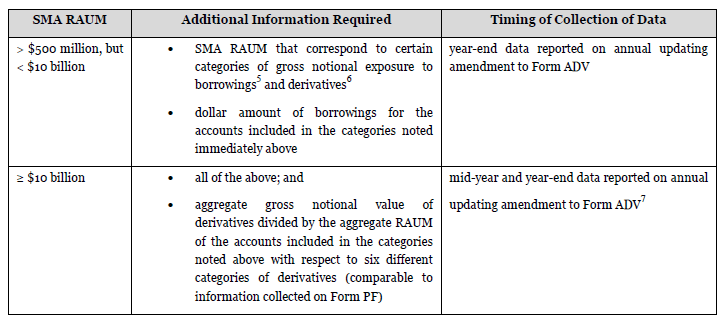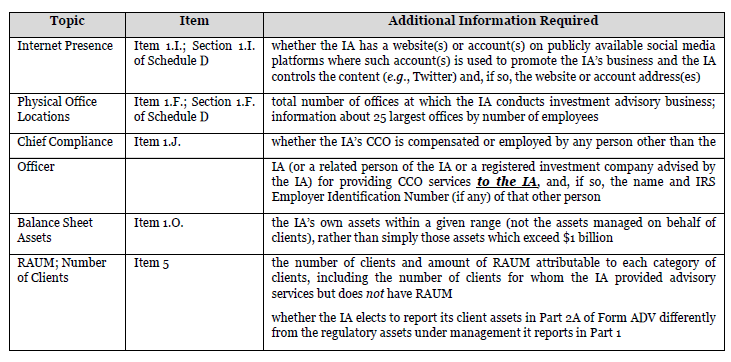Recognized as one of the most active and highly regarded investment management practices in the United States, our group represents all types of asset managers across the liquidity spectrum, including private equity funds, credit funds, hedge funds, venture capital funds, real estate funds, hybrid funds and family offices. We have successfully raised hundreds of billions of dollars for our clients, who benefit from our extensive market knowledge, industry-leading networking events and strong relationships with all major market participants.
New SEC Disclosure Requirements on Form ADV Become Effective October 1
September 26, 2017 Download PDF
Investment advisers should prepare for new Form ADV disclosure requirements that will go into effect on October 1, 2017 pursuant to rules adopted last year by the U.S. Securities and Exchange Commission (“SEC”)[1]. The amendments:
- require additional information on Part 1A of Form ADV about an investment adviser’s separately managed accounts (“SMAs”);
- require additional information on Part 1A of Form ADV about an investment adviser’s advisory business, including, among other things, branch office operations and the use of social media; and
- permit “umbrella registration” under a single Form ADV of related private fund advisers operating as a single advisory business.
For an investment adviser (an “IA”) on a December 31 fiscal year, the annual update to be filed in the first quarter of 2018 will be the first filing on the amended form. However, if an IA on a December 31 fiscal year is filing an other-than-annual amendment before its next annual update, the other-than-annual amendment will be the IA’s first filing on the amended form.
Separately Managed Accounts. The amendments to Form ADV require detailed information regarding SMAs to be provided on Schedule D of Part 1A. This information includes the types of assets held in SMAs, the use of derivatives and borrowings[2] in SMAs and the IA’s regulatory assets under management attributable to SMA’s (“SMA RAUM”). Notably, for this purpose, any accounts other than accounts of registered investment companies, business development companies and private funds or other pooled investment vehicles[3] are considered SMAs.
All IAs that report that they have regulatory assets under management attributable to SMAs are then required to report the approximate percentage of SMA RAUM invested in 12 broad asset categories. These categories include, among others, cash and cash equivalents, exchange-traded equity securities, non-exchange traded equity securities, U.S. government/agency bonds, corporate bonds, and derivatives.[4] If any assets fall under more than one category, IAs are permitted to use their own internal methodologies and the conventions of their service providers (if consistently applied) to determine how to categorize such assets. These methodologies should be consistent with how the IAs report internally and to current and prospective investors to ensure that assets are not double counted. Furthermore, depending upon the amount of SMA RAUM, the IA is required to complete more detailed questions regarding those SMAs as follows:

Certain IAs that are required to file an other-than-annual amendment to Form ADV between October 1, 2017 and the filer’s next annual amendment and do not have this additional information available, may respond “0” as a placeholder in order to submit their other-than-annual amendment. A corresponding note in the Miscellaneous section of Schedule D should identify that a placeholder value of “0” was entered.
Finally, IAs are required to identify any custodians that hold 10% or more of the IA’s SMA RAUM, as well as the amount of the IA’s SMA RAUM held at the custodian. The 10% threshold is intended to assist the SEC in identifying custodians that serve a significant number of IAs’ SMA clients. IAs are not required to report sub-custodians. Certain IAs that are required to file an other-than-annual amendment to Form ADV between October 1, 2017 and the filer’s next annual amendment and do not have this additional information available, may respond “0” as a placeholder in order to submit their other-than-annual amendment. A corresponding note in the Miscellaneous section of Schedule D should identify that a placeholder value of “0” was entered.
Umbrella Registration for Certain Private Fund Advisers. The amendments codify the regime introduced by the 2012 ABA No-Action Letter[8] regarding “umbrella registration” that permits related IAs (that is, IAs that control, are controlled by or are under common control with each other) operating as a single advisory business to file a single Form ADV. The amendments also clarify and expand the disclosure required with respect to each IA covered by the “umbrella registration”.[9] The conditions under which umbrella registration is available (consistent with the conditions set forth in the 2012 ABA No-Action Letter) are set out in Form ADV’s General Instructions as follows:
(i) The filing IA and each relying adviser (“RA”) advise only private funds and clients in SMAs that are “qualified clients” (as defined in Rule 205-3 under the Investment Advisers Act of 1940, as amended (the “Advisers Act”)) and that are otherwise eligible to invest in the private funds advised by the filing IA or an RA and whose accounts pursue investment objectives and strategies substantially similar or otherwise related to those of such private funds;
(ii) The filing IA has its principal office and place of business in the U.S. and, therefore, all of the substantive provisions of the Advisers Act and the rules thereunder apply to the filing IA’s and each RA’s dealings with each of its clients, regardless of whether any client or the filing IA or RA providing the advice is a U.S. person;
(iii) Each RA, its employees and the persons acting on its behalf are subject to the filing IA’s supervision and control and, therefore, each RA, its employees and the persons acting on its behalf are “persons associated with” the filing IA (as defined in §202(a)(17) of the Advisers Act);
(iv) The advisory activities of each RA are subject to the Advisers Act and the rules thereunder, and each RA is subject to examination by the SEC; and
(v) The filing IA and each RA operate under a single code of ethics adopted in accordance with Rule 204A-1 under the Advisers Act and a single set of written policies and procedures adopted and implemented in accordance with Rule 206(4)-(7) under the Advisers Act and administered by a single chief compliance officer (“CCO”) in accordance with that rule.
In addition, the SEC adopted a new Schedule R to Part 1A that must be completed for each RA. The schedule includes identifying information, basis for registration, and ownership information for each RA.[10] A new question in Part 7.B of Schedule D also requires identification of the particular adviser (whether the filing IA or an RA) that manages or sponsors each private fund reported on Form ADV.
Additional Identifying and Advisory Business Information. The amendments to Form ADV also require an IA to provide assorted additional information on Part 1A, including, among other things, the following:[11]

[1] See “Form ADV and Investment Advisers Act Rules” (August 25, 2016), available at https://www.sec.gov/rules/final/2016/ia-4509.pdf, https://www.sec.gov/rules/final/2016/ia-4509-appendix-a.pdf, https://www.sec.gov/rules/final/2016/ia-4509-appendix-b.pdf, https://www.sec.gov/rules/final/2016/ia-4509-appendix-c.pdf, and https://www.sec.gov/rules/final/2016/ia-4509-appendix-d.pdf (collectively, the “Adopting Release”). For a blackline reflecting the amendments to Form ADV, see https://www.sec.gov/rules/final/2016/ia-4509-form-adv-summary-of-changes.pdf. The SEC also issued additional guidance earlier this year, see “Frequently Asked Questions on Form ADV and IARD” (June 12, 2017), available at https://www.sec.gov/divisions/investment/iard/iardfaq.shtml (the “FAQs”).
[2] As discussed in more detail below, reporting on the use of borrowings and derivatives is only required with respect to SMAs with regulatory assets under management of at least $10 million.
[3] The FAQs note that, for purposes of Item 5.D, (i) pooled investment vehicles include, but are not limited to, private funds, (ii) it may be appropriate for an IA to treat a fund of one as a pooled investment vehicle in certain circumstances, e.g., where the fund seeks to raise capital from multiple investors but has only a single, initial investor for a period of time, or where all but one of the investors in the fund have redeemed their interests, and (iii) an IA generally should not consider a fund of one to be a pooled investment vehicle if the fund of one in fact operates as a means for the IA to provide individualized investment advice directly to the investor in the fund of one.
[4] IAs should not look through a SMA’s investment in funds to report the underlying asset type, as the SEC seeks to understand the extent to which SMAs’ assets are invested in funds.
[5] Borrowings includes traditional lending activities, such as client bank loans and margin accounts, secured and unsecured borrowings, short sales and transactions in which variation margin is owed, but has not been paid by the client because a certain threshold was not met. IAs should not report as borrowings, leverage embedded through derivatives, securities lending or repurchase agreements. Additionally, IAs are not required to report client borrowings of which they were unaware when such borrowings occurred.
[6] For this purpose, “gross notional exposure” is the percentage obtained by dividing (i) the sum of (a) the dollar amount of any borrowings and (b) the gross notional value of all derivatives, by (ii) the RAUM of the account.
[7] The amendment does not require the IA to file a semi-annual update to this information, but rather to include the information for both semi-annual periods in the IA’s annual update of its Form ADV.
[8] See American Bar Association, Business Law Section, SEC Staff Letter (Jan. 18, 2012), available at http://www.sec.gov/divisions/investment/noaction/2012/aba011812.htm (the “2012 ABA No-Action Letter”).
[9] Umbrella registration is not available for exempt reporting advisers.
[10] Consistent with the SEC’s prior no-action letters, the FAQs confirm that an IA is not required to file Schedule R with respect to a special purpose vehicle that acts as a private fund’s general partner or managing member and that relies upon the IA’s registration rather than separately registering.
[11] The SEC also adopted numerous clarifying and technical amendments to Form ADV which are not described in this memorandum.



